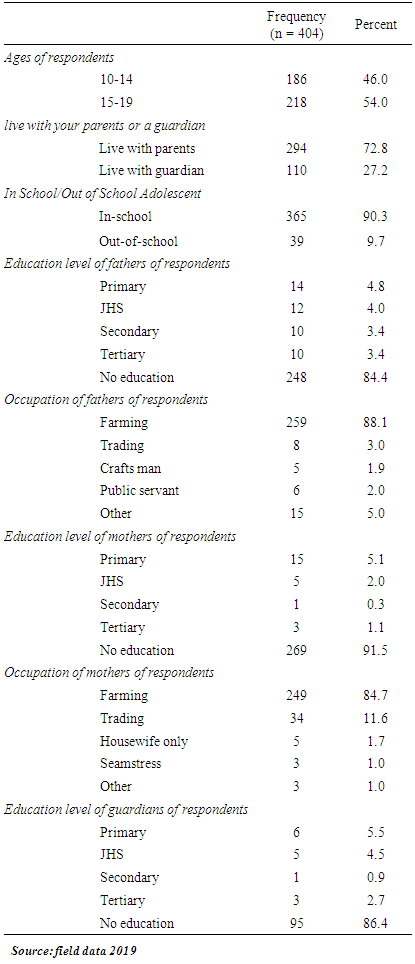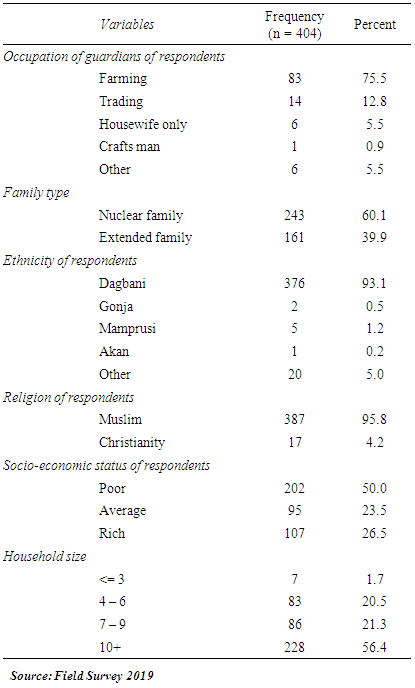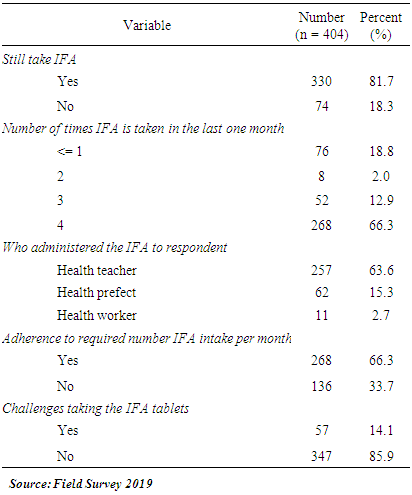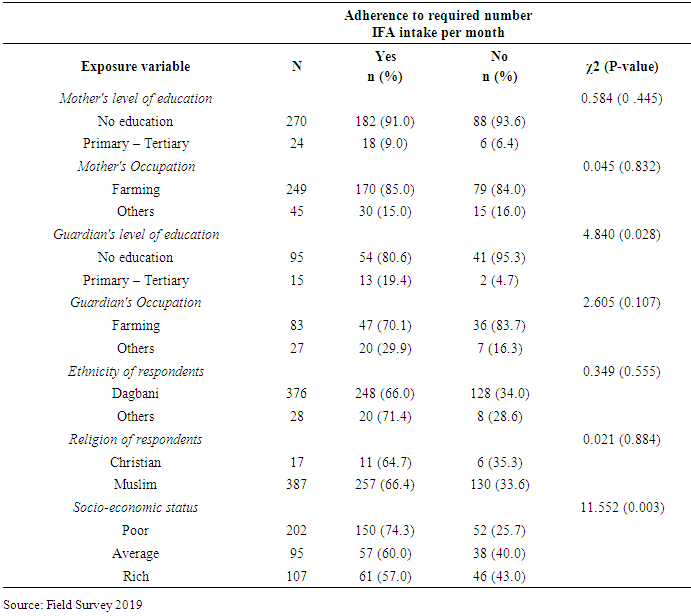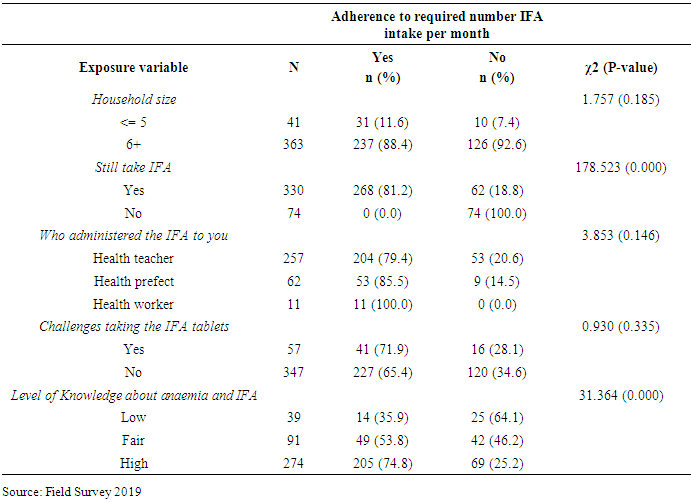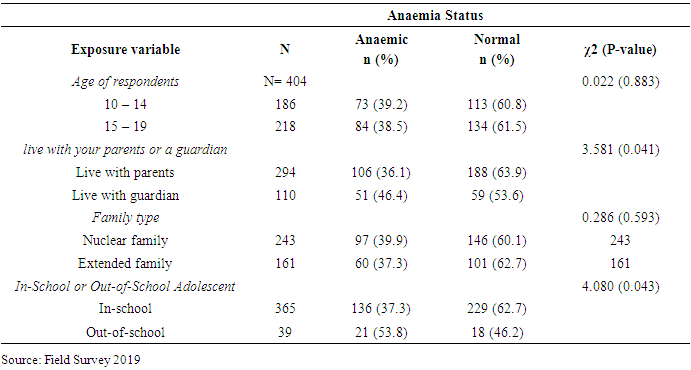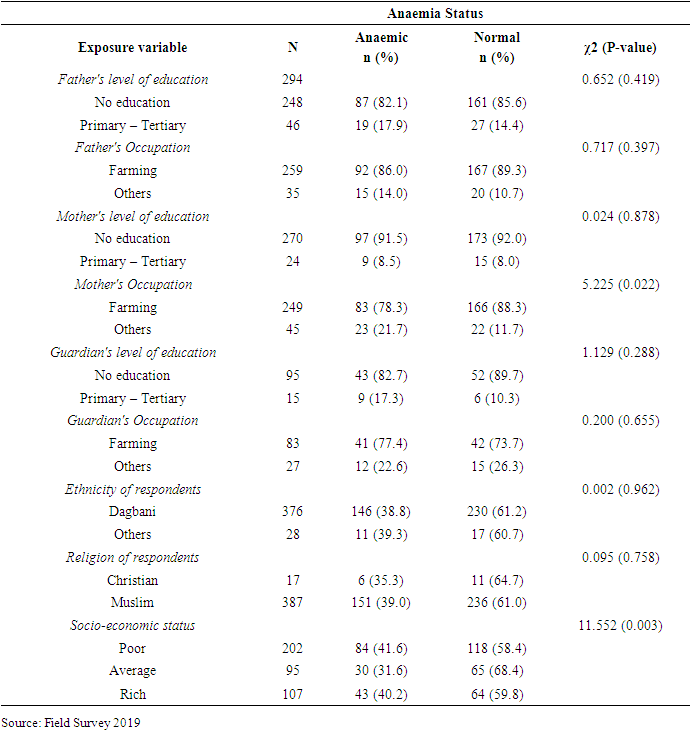-
Paper Information
- Paper Submission
-
Journal Information
- About This Journal
- Editorial Board
- Current Issue
- Archive
- Author Guidelines
- Contact Us
Public Health Research
p-ISSN: 2167-7263 e-ISSN: 2167-7247
2020; 10(5): 133-142
doi:10.5923/j.phr.20201005.01
Received: Sep. 9, 2020; Accepted: Sep. 30, 2020; Published: Oct. 15, 2020

Iron and Folic Acid Supplementation Compliance among Adolescent Girls in Karaga District, Ghana
Adadow Yidana1, Thomas Bavo Azongo2, Adisa Mohammed3
1University for Development Studies, School of Medicine and Health Sciences, Department of Community Health and Family Medicine
2University for Development Studies, School of Allied Health Sciences, Department of Public Health
3University for Development Studies, School of Allied Health Sciences, Department of Nutritional Sciences
Correspondence to: Adadow Yidana, University for Development Studies, School of Medicine and Health Sciences, Department of Community Health and Family Medicine.
| Email: |  |
Copyright © 2020 The Author(s). Published by Scientific & Academic Publishing.
This work is licensed under the Creative Commons Attribution International License (CC BY).
http://creativecommons.org/licenses/by/4.0/

Iron deficiency anaemia is a public health concern in developing countries. Weekly Iron and Folic Acid ingestion can reduce the prevalence of nutritional anaemia among adolescent girls. In recognising the problems of the adolescent girls, the Girls Iron and Folic Tablet Supplementation program was launched in 2017 to reduce the rate of anaemia in adolescents and to empower them with requisite knowledge on health, nutrition and other preventive practices through health education. This study was conducted to assess the compliance to iron and folic acid supplementation and iron status among adolescent girls in Karaga District in Ghana. The study employed a cross-sectional design using in-school and out-of-school adolescent girls. Cluster and simple random probability sampling techniques were employed and a sample size of 404 was selected from the population using Cochran’s formula. Most of the respondents (54%) were between the ages of 15 – 19 years. Also, 81% of them still take Iron and Folic Acid tablets. The study revealed that overall, apart from socio-economic status of respondents, guardian’s level of education and in or out of school adolescent, all other variables did not have any statistically significant (p > 0.05) relationship with the adherence to the required number of Iron and Folic Acid intake per month in Karaga District. The study also showed that the majority (84.7%) of the respondents who are adolescent girls have strong knowledge of anaemia and Iron and Folic Acid. The study showed that more than half of the respondents (61.1%) have Hb levels greater than or equal to 12g/dl. With 38.9% of the respondents having Hb levels less than 12g/dl, the prevalence according to WHO is “medium” with classifications <15% - “low”, 15 – 40%- “medium” and >40% - “high”. Despite the challenges experienced by the adolescents, there is high compliance in taking the IFA tablets. Social and Behavior Change Communication programs need to be strengthened to educate people at the communities on the essence of the tablets and also the existence of the supplementation program need to be enforced.
Keywords: Compliance, Iron, Folic Acid, Supplementation, Adolescents
Cite this paper: Adadow Yidana, Thomas Bavo Azongo, Adisa Mohammed, Iron and Folic Acid Supplementation Compliance among Adolescent Girls in Karaga District, Ghana, Public Health Research, Vol. 10 No. 5, 2020, pp. 133-142. doi: 10.5923/j.phr.20201005.01.
Article Outline
1. Background
- Iron Deficiency Anaemia (IDA) is in the top ten risk factors contributing to the global burden of disease. A severe public health problem exists when anaemia prevalence is ≥40% in any group (Horton, 2001). Adolescents are young people from the ages of 10 to 19 who constitute 1.2 billion of the world’s population (16%) (UNICEF, 2019). School going age and adolescence constitutes a dynamic period of growth and development leaving a strong foundation for good health and productivity in later life. Appropriate dietary intake is critical for forming good eating habits and provides the much-needed nutrients for growth, long-term health, cognition and educational achievements. A large proportion of the population globally is in the school-going age or adolescence, with more than three-quarters of these groups living in developing countries (Masibo, 2014).Weekly Iron and Folic acid Supplementation (WIFS) program is an evidence-based response to the prevailing anaemia situation amongst adolescents' through supervised weekly intake of IFA supplementation (Ripunjpy, 2018). Enforcing the health and nutritional status of women in their own right, throughout the life cycle is necessary to ensure the health and nutrition of all children (EWEC Technical Content Workstream Working Group on Nutrition, 2015). In anyways, adolescent girls are at the heart of this life-course approach, because, a young adolescent girl is still a child but yet will soon be a mother. Hence, efforts to improve nutrition need to pay special attention particularly to women of reproductive age and adolescent girls (EWEC Technical Content Workstream Working Group on Nutrition, 2015).Adolescents (age 10-19 years) are at high risk of IDA due to an accelerated increase in requirements for iron, poor dietary intake of iron, high rate of infection and worm infestation as well as the social norm of early marriage and adolescent pregnancy (WHO, 2011). According to (Williamson, 2013), 70,000 young women die due to pregnancy and childbirth issues and 19% (7.3 million girls) of this age group become pregnant annually before age 18. Policy-makers must make efforts to invest enough on anaemia now as a means to promote economic and human resource development and good health and wellbeing. The Indian national and state governments with the help of the United Nations International Children Education Fund (UNICEF) started the Adolescent Girls Anaemia Control Program since 2000. This program uses schools to deliver the tablets to girls along with Anganwadi centres (village level child development centre) under ICDS (Integrated Child Development Services) program to provide benefits to as many adolescent girls as possible. The number of adolescent girls benefiting from the program increased from 8.8 million by the end of 2005 to 14.5 million by the end of 2010. In 2011, the Government of India launched the Rajiv Gandhi Scheme for the Empowerment of Adolescent Girls, also known as SABLA. The program was reaching 27.6 million adolescent girls in 13 states using schools, Anganwadi centres and SABLA as the delivery platforms (Aguayo, Paintal, & Singh, 2013).The WIFS strategy for reducing adolescent anaemia has been implemented in different parts of the world and its effectiveness had been proven. A study done by (Rakesh et al., 2015) indicated that anaemia was high among adolescents who were not compliant with the WIFS and those indicated a regular consumption of tea or coffee along with their main meals in Kerala, India. Again, a study by Dhikale et al. (2015) on operational status of the supplementation indicated good compliance. Besides, Sajna and Jacob (2017) study on adherence to WIFS among the school children of Thrissur Corporation indicated low adherence. In the same vane, Ramya carried out a cross-sectional study on factors influencing weekly Iron Folic Acid supplementation program (WIFS) among school-children and concluded that regular supply of the supplement and sensitization are key to the program success (Ramya, 2016).Within Africa, a study in Kenya by Kamau, Mirie and Kimani (2018) on IFA compliance among pregnant women indicated low compliance. A similar study was carried out in eight rural districts of Ethiopia by Jikamom and Samuel (2018) the results of which revealed unsatisfactory iron supplementation among women who gave birth in the preceding year. In recent times, the course to fight anaemia has attracted the attention of policymakers in health across Africa. To carry through the efforts, IFA tablets have been provided free to adolescent girls (ages 10-19) both in-school and out-of-school. The Girls Iron and Folic acid Tablet Supplementation (GIFTS) to reduce the high rate of anaemia among these girls and also improve their health (WHO, 2018).In Ghana, 4500 teachers and 3000 health personnel have been trained to implement the program by issuing the IFA tablets to adolescent girls and also health and nutrition education on integrated anaemia control. Every Wednesday after adolescents’ in-school have finished taking their lunch, teachers encourage as well as supervise them to ingest the supplement. At the community level, community health workers also deliver a monthly supply of the supplements to adolescent girls who are out of school. These girls are also educated, counselled and supervised to ingest the first dose of the tablet at the health facility under the Direct Observation Therapy (DOT).The first stage of the program was piloted in four out of the ten regions in Ghana, with the aim to scale-up to other regions. Within the four Regions, the program target to reach 360,000 adolescent girls in both Junior and Senior High schools and Technical Vocational Education training institutes and 600,000 adolescent girls who are out of school. The first stage was expected to end in 2019, to reduce anaemia by 20% in the four regions and also increase the knowledge of the adolescents on anaemia, nutrition and other preventive practices (WHO, 2018). It has been observed that most of the researches have focused on the prevalence and factors influencing adherence to Iron Folic Acid Supplementation in pregnant women with little attention on factors influencing adherence among adolescent girls. This paper sought to determine the compliance level of the Girls Iron and Folic Acid Tablet Supplementation program in the Karaga District in the Northern Region of Ghana.
2. Methodology
2.1. Study Setting and Design
- Karaga District is one of the 26 districts in the Northern Region with its administrative departments and district capital located in Karaga. It has a total land size area of about 2,958 sq. km which is about 4.2% of the land area of Northern Region. The district surrounded from the East-Gusheigu Municipality to the South-East Mampurusi Municipality, and the West-Savelugu-Nantong District. Predominantly, the inhabitants of Karaga District are farmers with about 25% cultivating Soya beans, 35%-groundnut, 17%-maize, 10%-rice, 5%-yam and 7% livestock rearing. Additionally, some few women also engaged in petty trading and Shea butter processing and production. The predominant ethnic group is Dagombas with Islam as the dominant religion. is Islam, with some few Christians and traditional believers. With an estimated growth rate of 2.9% per annum, Karaga District in 2018 is said to have a projected population of 92,718 based on the 2010 Population and Housing Census. Based on the idea of responses being solicited directly from respondents at a particular point in time, the cross-sectional research design type was adopted for the study. A cross-sectional study in medical or social research is an observational study that analyses data collected from a different population or a representative subset at a specific point in time (Setia, 2016).
2.2. Target Population
- The target population for this study were adolescent girls in Karaga District. They include adolescent girls in school and out of school (10 to 19 years).
2.3. Sampling
- The sample size would be determined by the application of the Cochrane formula using the prevalence rate (48%) of anaemia
 The minimum sample size for the study will be 384 adolescent girls. Since the minimum sample size of the study is 384, an approximation of 5% (20) is added. So, 404 respondents were used to cater for contingencies. A cluster sampling approach was used to select communities. Respondents were selected from these clusters using population proportion to size with the aid of the Emergency Nutrition Assessment tool (ENA). The in-school registers and the out of school registers were merged as one register. Simple random sampling was then used to draw the samples from each community.
The minimum sample size for the study will be 384 adolescent girls. Since the minimum sample size of the study is 384, an approximation of 5% (20) is added. So, 404 respondents were used to cater for contingencies. A cluster sampling approach was used to select communities. Respondents were selected from these clusters using population proportion to size with the aid of the Emergency Nutrition Assessment tool (ENA). The in-school registers and the out of school registers were merged as one register. Simple random sampling was then used to draw the samples from each community.2.4. Data Collection Techniques and Tools
- The technique of data collection was survey and questionnaires were used as tools to solicit respondents’ views on the subject matter. Questionnaires are the best tool for soliciting data from respondents in a survey study or research (Kerlinger, 1974). The Hb was checked using the haemocue machine (Hb 301).
2.5. Data Analysis
- Quantitative data was analyzed using Statistical Package for Social Science (SPSS) version 23. The adherence to IFA supplementation and anaemia status was analyzed using descriptive statistics and presented as proportions in tables. Chi-square was used to determine the association between predictors and iron status.
2.6. Pre-test
- The tools for the study were pre-tested in Dabokpa Junior High School in Tamale Metropolis to check for consistency, reliability and validity, 20 adolescent girls (ages 10-19) were interviewed and Hb checked.
2.7. Ethical Consideration
- Ethical clearance was sought from the Navrongo Health Research Centre Ethical Review Board and the reference number (App/IFAsupp/08/2019) and consent taken from headteachers, parents and focal persons of the Ghana Health Service and Ghana Education Service in charge of weekly supplementation. Beyond that, great care was taken to provide honest and clear information about the objectives of the study and how the results would be used.
3. Results
3.1. Socio-demographic Characteristics of Respondents
- Table 1 and 2 displays the results on the demographic distribution of respondents. It could be seen that four hundred and four adolescent girls are within the age bracket of ten to nineteen years. Of the total interviewed, 376 (93.1%) were Dagombas. The mean age of the respondents was 14.61 years (standard deviation of 2.3 years). About 54.0% of the respondents were between the ages of 15 years and 19 years. The modal age group was 15-19 years. Again, 46.0% were between 10-14 years. Also, 72.8% reported living with their parents at the time of the study. Again, 90.3% were in school. Further, 84.4% of the fathers of the respondents had no formal education. Additionally, 91.5% of the mothers of the respondents had no formal education.
|
|
3.2. Iron Folic Acid Intake and Adherence by Respondents
- Table 3 shows the adherence level and iron status of respondents. It could be seen that majority (81.7%) of the respondents do take the IFA tablets. Also, 66% of the respondents took the IFA tablets four times in the immediate past month, which reflects the degree of compliance with the standard of taking IFA tablets. Again, 19% of respondents who took the tablet either took it once or never took at all, 2% took it twice and 12.9% took it thrice in the immediate past month. This confirms the significant proportion of respondents (66.3%) that conforms to the required number of IFA intake per month.
|
3.3. Challenges Encountered During IFA Intake
- From the study, 85.9% of the respondents do not have challenges taking IFA tablets. With the respondents who have challenges, 61.4% faces challenges including perceiving the IFA tablets as Family Planning pills, lack of potable water to take tablets, heavy menstrual flow after taking the tablet, hunger and dizziness. See figure 1.
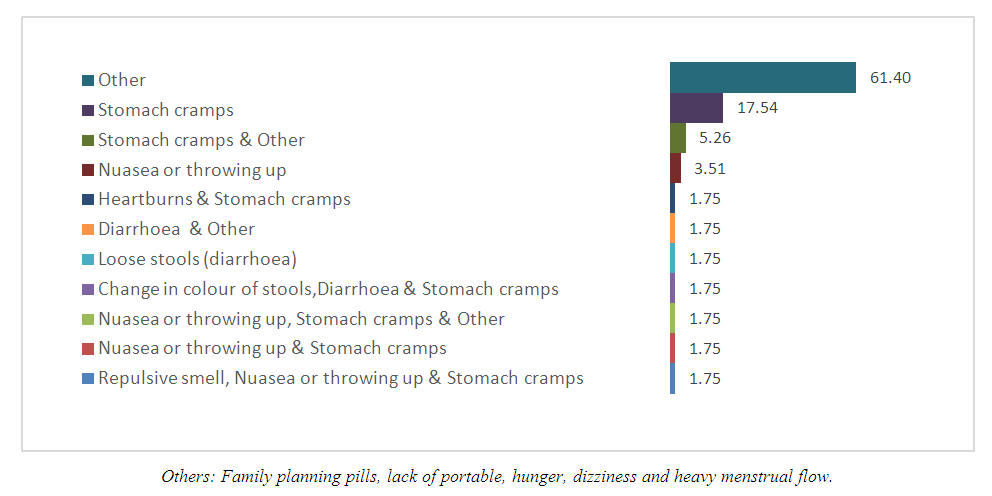 | Figure 1. Challenges faced in taking IFA tablets (Source: Field Survey 2019) |
3.4. Anaemia Status
- As evident, 61.1% of the respondents have Hb levels greater than or equal to 12g/dl, which falls under the standard accepted level. However, 38.9% of the respondents have Hb levels less than 12gdl which indicates they are anaemic. This result generally means that about 39% of the time, an adolescent is anaemic in Karaga District. See figure 2.
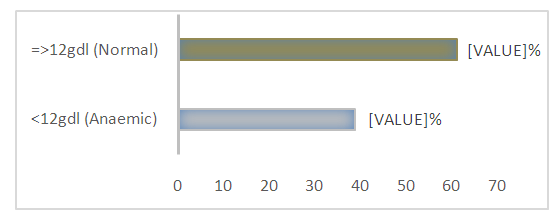 | Figure 2. Anaemia status of respondents (Source: Field Survey, 2019) |
3.5. Deworming and Anaemia Prevalence
- From table 4, it could be seen that of the number of adolescent girls (44) that have been dewormed in the past week majority (54.5%) of them have high Hb levels. see table 4.
|
3.6. Association between the Socio-Demographic- Characteristics, Knowledge about Anaemia and IFA and Adherence to Required Number IFA Intake Per Month
- From tables 5, 6, and 7, it could be seen that socio-economic status of respondents (0.003), guardian’s level of education (0.028) and in school or out of school adolescent (0.000) have statistically significant relationships with knowledge about anaemia and IFA and adherence to the required number of IFA intake per month with significant p-values at 0.05 level of significance. Again, intake of IFA tablets and level of knowledge about anaemia and IFA have statistically significant relationships with the adherence to the number of IFA intake per month. This is evident with significant p-values of 0.000 and 0.000 respectively. The socio-demographic characteristics influence the adherence to IFA supplementation among adolescents.
|
|
|
3.7. Association between Respondents’ Socio-Demographic Characteristics, and Anaemia Status
- Table 8, 9, and 10 presents the association between the socio-demographic characteristics of respondents and anaemia status. Overall, it could be seen that whether a respondent is in school or out of school (0.041), lives with parents or guardian (0.043), mother’s occupation (0.022) and parent’s socio-economic status of respondents (0.003) have statistically significant relationships and is strongly associated with the anaemia status of the respondent at 5% level of significance.
|
|
|
4. Discussion
- The study has revealed 81.7% of respondents still take the IFA tablets which seem very high and good as compared to similar studies carried out by the Ghana Statistical Service (GSS) which showed 53% for rural adolescents and women. Although most adolescents still take the IFA tablets, only 66.3% took the required dosage (4 times) in the immediate past month (WHO, 2011). Again, about 20.8% (18.8 + 2.0) of adolescents took less than 3 IFA tablets in the immediate past month. Additionally, 63.6% of the IFA pills were administered in schools by school health coordinators, with 15.3% administered by health prefects and as low as 2.7% administered by health workers. Of the number taking the IFA pills, 85.9% did not have any challenge during the administration of the tablets. Slightly less than a fifth (14.1%) of the adolescents had challenges taking the IFA tablets which are low compared to the study by Bilimale et al. (2010).The study showed that 61.1% have Hb levels greater than or equal to 12g/dl. With 38.9% of the respondents having Hb levels less than 12g/dl, the prevalence according to WHO is “medium” with classifications <15% - “low”, 15 – 40%- “medium” and >40% - “high” (Horton, 2001). According to the findings of Ghana Demographic and Health Survey, anaemia among adolescent girls (15 – 19 years) at the country level was the highest across other categories (GDHS 2014). Besides, a similar survey in a study conducted in Vietnam resulted in a similar anaemia prevalence rate of 38% which could be largely attributed to hookworm infection Stoltzfus and Dreyfuss (1998). However, out of the total respondents, 10.9% have dewormed in the immediate past month. Comparing results, it could be seen that the percentage of respondents who still take the IFA tablets (87.17%) is almost equal to the percentage of adolescent girls who have not dewormed in the last one month (89.1%). This result could also be compared to Casey et al. (2009) who asserted that regular deworming is associated with reduced prevalence and severity of anaemia and hookworm infection in non-pregnant women. The study showed that the majority (84.7%) of the respondents who are adolescent girls have strong knowledge on anaemia and IFA. Also, a similar study conducted in Nigeria by Patel et al. (2018) showed that about 74% of the respondents had some knowledge of anaemia and how to prevent it. This difference observed could be because the majority of the IFA tablets were administered to them by their health teacher. In the process of the IFA pills administration or before the administration, the health teachers could take some time out to explain the drugs and its essence and importance. From the study, it could be seen that most of the respondents could briefly explain anaemia and haemoglobin, they could also identify the blood cells responsible for anaemia and other questions on areas such as symptoms, prevention and severity. The study revealed that overall, apart from socio-economic status of respondents, guardian’s level of education and in or out of school adolescent, all other variables did not have any statistical significant (p > 0.05) relationship with the adherence to the required number of IFA intake per month in Karaga District. In a similar study conducted by Wendt et al. (2018) in India, they reported inadequate IFA supply as the major constraint to IFA adherence among adolescents. Also on the association between respondents’ socio-demographic characteristics and anaemia status, the study revealed exposure variables such as mother’s occupation, in school or out of school respondent, lives with parent or guardian and parent’s socio-economic status have significant (p < 0.05) relationship with the anaemia status of adolescent girls in Karaga District. This result could be because mothers occupation plays a crucial role in the health and well being of their children based on the fact that a financially empowered mother have enough resources to take care of their children especially in terms of diet diversity and hygiene. Also since the majority of the IFA pills were administered by health teachers in schools, there is the need for adolescent girls to be in school to able to receive the pills. Results from the focus group discussion revealed that initially when the supplement was introduced, pupils were thinking that it was family planning drugs due to the rumours circulating in town so whenever they were given to take they throw it away but when they realize that the female teachers were also taking it then they started to also take it. So as a way of improving compliance, they had to bring in SHEP coordinator to educate the students more on the IFA pills. Also as teachers, they believe it is a move in the right direction for adolescent girls to take iron and folic acid pills to help replace lost blood during menstruation and also to reduce anaemia. Also according to results of the study, some adolescent girls refuse to come to school during their menstruation as a result of the pain they go through but since they started taking the supplements there have been an improvement in attendance and hence academic performance. With regards to some problems encountered while giving the IFA pills, some of the health teachers have problems with observing the DOT policy because they run out of the water and hence they are compelled to let the girls go with the drugs with the impression that they would get water elsewhere and take the pills. When this happens, some of the respondents might as well throw the drug away or simply refuse to take since there is no monitoring. Finally, to improve on the intake of the IFA pills, health teachers in the focus group suggested the female teachers also should set an example by taking the pills first whenever the distribution is about to take place to incite the adolescent girls to also take it.
5. Conclusions
- Based on the objective, it can be concluded that adolescent girls still take the IFA pills and most (66.3) of them take in the required dosage. Also, 61.1% have their HB level ≥12gd/l with the anaemia level being 38.9%. From the study, it was found that most adolescent girls have strong knowledge of anaemia and IFA. Although the required IFA dosage is four times, some adolescent girls still took less, a situation attributed to occasional unavailability of the IFA tablets and also, the shortage of water thereby leading to the inability of the health teachers to monitor the intake of the drugs. Also, most of the IFA pills were administered in schools by school health coordinators with minimal challenges experienced by the adolescent girls during the administration of the tablets. Few challenges encountered include the intake of family planning pills, lack of potable water, high menstrual flow and headaches. Despite the challenges, adolescent girls still take the IFA tablet. Based on the objective, it can be concluded that adolescent girls in Karaga still take the IFA pills and most of them take in the required dosage. To improve IFA intake, SBCC programs need to be strengthened to create awareness on the importance of the tablet and also the existence of the supplementation program.
 Abstract
Abstract Reference
Reference Full-Text PDF
Full-Text PDF Full-text HTML
Full-text HTML